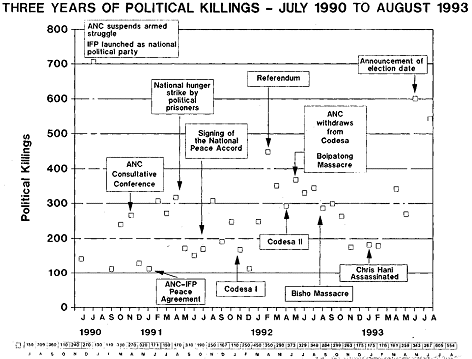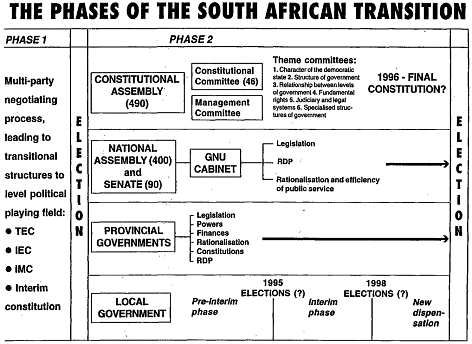This resource is hosted by the Nelson Mandela Foundation, but was compiled and authored by Padraig O’Malley. It is the product of almost two decades of research and includes analyses, chronologies, historical documents, and interviews from the apartheid and post-apartheid eras.
The South African Transition
PREPARATORY PHASE
Feb. 1990 | Release of Nelson Mandela, unbanning of organisations |
May 1990-91 | Groote Schuur, Pretoria and DF Malan Minutes Peace process starts |
Sept. 1991 | Signing of National Peace Accord |
Nov. 1991 | Preparatory conference for multi-party forum |
Dec. 1991 | Codesa I - Declaration of Intent signed |
Feb. 1992 | Codesa working groups start work |
March 1992 | Whites-only referendum |
June 1992 | Codesa II deadlock Boipatong massacre, ANC withdraws |
July 1992 | Bisho massacre |
Sept. 1992 | Record of Understanding between ANC, SA Government |
PHASE I - PRE-ELECTION PHASE
March 1993 | Multi-party planning conference - MPNP set up |
April 1993 | Chris Hani killed |
May 1993 | MPNP starts work in seven technical committees |
Nov. 1993 | Constitution for transition agreed at plenary |
Dec. 1993 | Parliament ratifies negotiated legislation |
Jan.1994 | Transition structures set up |
April 1994 | Election |
The South African Transition Process
Transitional Executive Council and SA Government
Pre-election Process:
*. Electioneering
*. Keep transition process intact
*. Pressure on parties outside to join/participate
*. Levelling of poll playing fields
1994 Election
Election declared free and fair
Constitutional Assembly
Interim Government of National Unity
(Legitimacy and effectivity combined)
*. Constitution-making
*. Governance
*. Reconstruction and development
*. Provincial governments established
Adoption of Constitution
Interim Government of National Unity
*. Governance
*. Reconstruction and development
*. Provincial governments settled
From Domination And Struggle To Negotiation
NP/SA GOVERNMENT | ANC |
Mind-set: Domination ("power-sharing") | Mind-set: Struggle ("transfer of power") |
Internal pressures •. The socio-economic demise of apartheid •. Violence and unrest •. Mass action •. NGO contact with ANC •. Securocrats vs technocrats | Internal pressures •. Differences in approach: armed struggle interchangeable with negotiations •. Myth of military victory exploded •. Did not want to inherit an economic waste land |
External pressures •. International political •. International economic (financial sanctions) | External pressures •. International political (West) •. International economic (East and West) |
Factors facilitating change •. Pressures •. Demise of East Bloc •. Exploiting opportunities nationally and internationally •. Namibia | Factors facilitating change •. Pressures •. Demise of East Bloc •. Exploiting opportunities nationally and internationally •. Desire to be in government sooner rather than later |
Click on image to enlarge
Click on image to enlarge
Record of Understanding
Paragraph 2:
"The understandings on issues and obstacles included the following, although it was observed that there are still other important matters that will receive attention during the process of negotiation: (a) The government and the ANC agreed that there is a need for a democratic constituent assembly/ constitution-making body and that for such a body to be democratic it must:
Ø. be democratically elected;
Ø. draft and adopt the new constitution, implying that it should sit as a single chamber;
Ø. be bound only by agreed constitutional principles;
Ø. have a fixed time frame;
Ø. have adequate deadlock-breaking mechanisms;
Ø. function democratically, ie, arrive at its decisions democratically with certain agreed-to majorities; and
Ø. be elected within an agreed predetermined time period.
Improvements in the Negotiating Process & Structures
1.. The Negotiating Forum as report back mechanism
2.. The Negotiating Council as Negotiating body
3.. The Planning Committee as "process guardians"
4.. The Technical Committees as compromise-seeking and deadlock-breaking mechanisms
5.. The transparancy and openness to the media
6.. Women representation
7.. The ongoing bilaterals
Key Compromises
1.. IGNU
•. Proportional representation
•. Consensus-geared
•. Executive
-. President
-. Two deputy presidents
•. Five-year rule
2.. POWERS OF PROVINCES
•. Provinces have effective legislative powers in 29 areas
•. Include health, education, police, housing, agriculture, language policy, tourism
•. Override of centre limited
•. Large role for Constitutional Court
•. National Revenue Fund
3.. LARGE ROLE FOR FINANCIAL AND FISCAL COMMISSION
4.. LARGE ROLE FOR SENATE
5.. CONSTITUTION-MAKING A TWO-YEAR PROCESS BUT IGNU LASTS FOR FIVE YEARS
6.. PROVISION MADE FOR A VOLKSTAAT COUNCIL
7.. STRONGER FISCAL POWERS FOR PROVINCES
8.. DOUBLE BALLOT
Constitutional Principles
Single state, common citizenship, democracy Fundamental rights, freedoms and civil liberties No discrimination, equality before the law Constitution supreme and binding Separate powers for legislature, executive, judiciary Independent judiciary and Constitutional Court
Multiparty government at three levels, regular elections, common voters' roll, proportional representation
Freedom of information, accountable administration
Diversity of language and culture acknowledged, collective rights of self-determination recognised and protected
Status of traditional leaders acknowledged Special majorities to amend Constitution Clear criteria for allocation of powers to different levels of government
Powers and functions of the national and provincial governments, and the boundaries of the provinces defined in the final Constitution
Each level of government has a constitutional right to an equitable share of revenue collected nationally
Provision made for right of self-determination in a territorial entity (Volkstaat Council)
The Constitutional Principles will not preclude constitutional provision for a notion of the right to self-determination, provided there is substantial support for such a form of self-determination. If a territorial entity in this regard is established before the new constitutional text is adopted, it shall be entrenched in the final Constitution
No new national executive or election before 30 April 1999
An Evaluation of the Three-Phase Transition as a process
a Preparatory phase
Ø. At the time undefined
Ø. Necessary
a Phase 1
Ø. "Institutionalising" phase
Ø. Alliances, formal and informal
Ø. Bridging the gap between struggle, domination and government of national unity
Ø. Maximum inclusivity attained
Ø. Economy took strain
a Phase 2
Government of National Unity Provinciail governments Drafting of "final" Constitution Reconstruction and development Frustrated socio-economic expectations Alliances kept
a Phase 3
Ø. Constitution in place
Ø. RDP on its way
Ø. Provincial governments settled
Ø. Frustrated socio-economic expectations
Ø. New alliances?
Features of the SA Transition
1.. De-demonising and discovering of mutual South Africanness.
2.. Acceptance of the importance of process ("meta-negotiations") and dealing with it before starting to finalise the content of the negotiations. The realisation of the importance of consultation and not unilateralism.
. After the bilateral "deal", managing the process and using the multiparty structures to maintain legitimacy.
3.. The lack of outside facilitators, but the use of credible and non-partisan organisations for process, secretariat and administrative functions.
5.. The "invention" of bilaterals and bosberade.
6.. Tertius Myburgh: "The diversity of South Africa makes victory impossible for any party, and therefore makes compromise inescapable for all parties."
. In a sense, compromise resulted from the mutual weakness of antagonists. This led to the combining of legitimacy and numbers on the one hand, and efficiency and power on the other.
7.. Popularising success and so breaking down resistance.
8.. Maintaining the "balance of forces": Both the ANC and NP kept their power bases intact and maintained a relative amount of cohesion.
9.. The creation of a symbolic victory for both sides (but especially for the formerly "oppressed").
10.. Capacity to forgive and start reconciliation (forgetting?).

